What is difference between electric field and electric field intensity?
The Basic Difference between electric field and electric field intensity is that, The electric field is a region around a charge in which it exerts an electrostatic force on other charges. While the strength of the electric field at any point in space is called electric field intensity. It is a vector quantity. Its unit is NC¯¹.
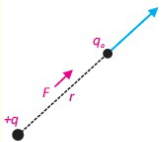 According to coulomb’s law, if a unit positive charge q0 (call it a test charge) is brought near a charge q (call a field charge) placed in space, the charge q0 will experience a force. The value of this force depends upon the distance between the two charges. If the charge q0 is moved away from q, this force would decrease till at a certain distance the force would be practically reduced to zero. The charge q0 is then out of the influence of charge q.
According to coulomb’s law, if a unit positive charge q0 (call it a test charge) is brought near a charge q (call a field charge) placed in space, the charge q0 will experience a force. The value of this force depends upon the distance between the two charges. If the charge q0 is moved away from q, this force would decrease till at a certain distance the force would be practically reduced to zero. The charge q0 is then out of the influence of charge q.
The region of space surrounding the charge q in which it exerts a force on the charge q0 is known as E.F of the charge q. Mathematically it is expressed as:
E =F/q0
The direction of the vector E is the same as the direction of F, because q0 is a positive scalar. Dimensionally, the E.F is force per unit charge, and its SI unit is the newton/coulomb (N/C).
Note the similarity with the gravitational field, in which g (which is usually expressed in units m/sec2) can also be expressed as the force per unit mass in units of newton/kilogram. Both the gravitational and electric fields can be expressed as a force divided by a property (mass or charge)of the test body. Below the table of some electric fields that occur in a few situations.
| Location | Electric field (N/C) |
| At the surface of a uranium nucleus | 3×1021 |
| Within a hydrogen atom, at the electron orbit | 3×1011 |
| Electric breakdown occurs in air | 3 × 106 |
| At the charged drum of a photocopier | 105 |
| The electron beam accelerator in a TV set | 105 |
| Near a charged plastic comb | 103 |
| In the lower atmosphere | 102 |
| Inside the copper wire of household circuits | 10-2 |
See also: Difference between electric and magnetic field
Electric field intensity
“The strength of an E.F at any point in space is known as electric field intensity. “In order to find the value of electric intensity at a point in the field, of charge +q, we place a test charge q0 at that point, as shown in figure

Electric field intensity formula
If F is the force acting on the test charge q0, the electric field intensity would be given by:
E = F/q0 ……… (1)
The electric field intensity at any point is defined as the force acting on a unit positive charge placed at that point. Where F is the electrostatic force between the source charge ‘q’ and the test charge ‘q0‘.The test charge ‘q0‘, should be very small, so that it cannot disturb the field produced by source charge ‘q’.Therefore the electric field intensity can be written as:
![]() ………….(2)
………….(2)
Electric field intensity due to point charge
Consider a test charge ‘q0‘ placed at point P in the electric field of a point charge ‘q’ at a distance ‘r’ apart.

We want to find out electric field intensity at point ‘p’ due to a point charge ‘q’. The electrostatic force ‘F’ between ‘q’ and ‘q0‘ can find out by using the expression:

The electric field intensity ‘E’ due to a point charge ‘q’ can be obtained by putting the value of electrostatic force in equation (1).
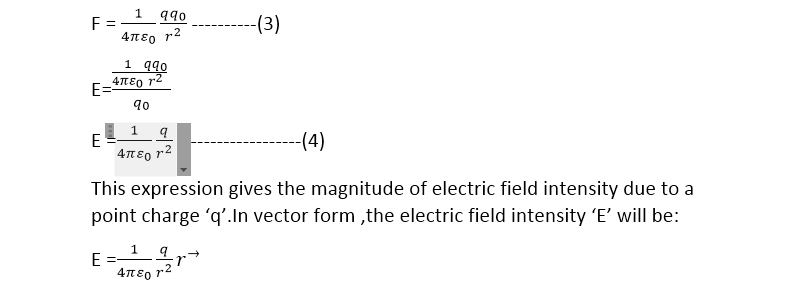
Where r→ is the unit vector which gives the direction of E.F intensity.
See also: Difference between coulomb’s law and newton’s law of gravitation
Electric field video
Electric Field Lines
A visual representation of the electric field can be obtained in terms of electric field lines; an idea proposed by Michael Faraday. Electric field lines can be thought of a “map” that provides information about the direction and strength of the electric field at various places. As electric field lines provide information about the electric force exerted on a charge, the lines are commonly called” lines of force”.
To introduce electric field lines, we place positive test charges each of magnitude q0 at different places but at equal distances from a positive charge +q.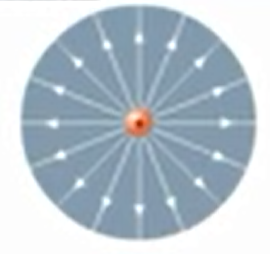
The above figure shows that each test charge will experience a repulsive force, as indicated by arrows. Therefore, the E.F created by the charge +q is directed radially outward as shown in the figure below. It shows corresponding field lines which show the field direction.
.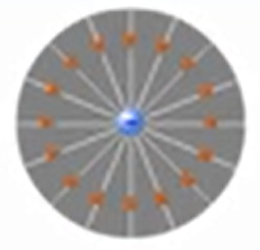
In case of a negative charge, the lines are radial “inward”, because the force on a positive test charge is now of attraction, indicating the E.F points inward.
Above both figures represent two-dimensional pictures of the field lines. However, E.F lines emerge from the charges in three dimensions, and an infinite number of lines could be drawn.
The E.F lines “map” also provides information about the strength of the electric field. As we noticed in the above figures that field lines are closer to each other near charges where the field is strong while they continuously spread out indicating a continuous decrease in the field strength.
“The number of lines per unit area passing perpendicularly through an area is proportional to the magnitude of the electric field.”
The electric field lines are curved in case of two identical separated charges in the below figure. It shows the pattern of lines associated with two identical positive point charges of equal magnitude. It reveals that the lines in the region between two like charges seem to repel each other. The behavior of identical negative charges will be exactly the same. The middle region shows the presence of a zero-field spot or neutral zone.
The field lines start from positive charge and end on a negative charge. In the regions where the field lines are parallel and equally spaced, the same number of lines pass per unit area, and therefore, field is uniform on all points.
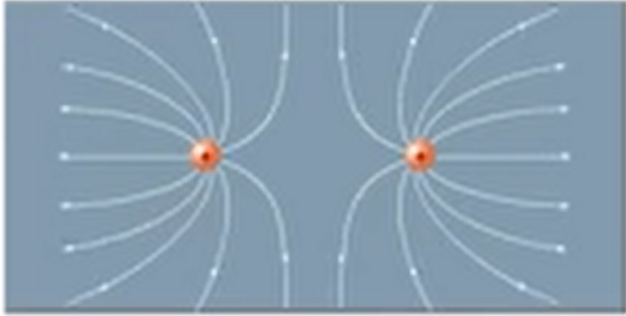
The above figure shows the field lines between the plates of a parallel plate capacitor. The field is uniform in the middle region where field lines are equally spaced. In the central region of a parallel plate capacitor, the electric field lines are parallel and evenly spaced, indicating that the electric field there has the same magnitude and direction at all points.
Properties of electric field lines
- Electric field lines originate from positive charges and end on negative charges.
- The tangent to a field line at any point gives the direction of the electric field at that point.
- The lines are closer where the field is strong, the lines are farther apart where the field is weak.
- No two lines cross each other. This is because field lines have only one direction. If the lines cross, field lines could have more than one direction.
You can clear more concepts about electric field lines visually in the video below.

I don’t see any difference between Electric Field Intensity and Electric Field Strength? Are they the same? And if so, why are there two different names for the same phenomenon?
See the question title again, there is a difference between the electric field and electric field strength, not the difference between electric field intensity and electric field strength.
You are doing a great job
Continue